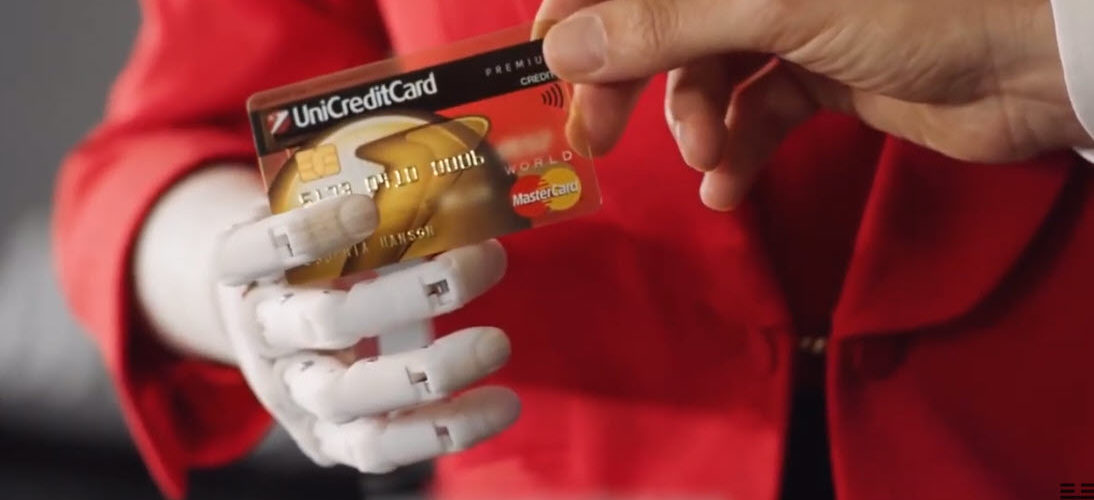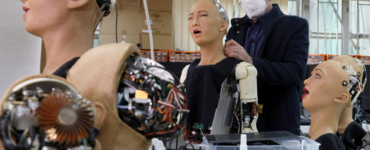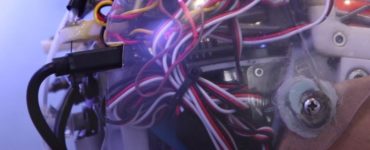Social robots living and working with humans must be able to navigate environments never designed for use by robots. Arms and hands are a vital tool for robots to manipulate common everyday objects, like door handles, pens, keyboards, or switches, not to mention giving humans handshakes or high-fives!
Hands are also an essential means of communicating between people. They can be used as nonverbal shortcuts, like giving a thumbs up, or as a means to express a variety of different emotions. By having a human-like hand design, social robots can take advantage of these many nonverbal cues humans use to communicate.
Sophia the Robot, the latest and most advanced robot in the Hanson family of robots, uses her robotic arms and hands to gesture while she speaks. She can use hand movements to emphasize specific points or use them to help convey emotions.
Sophia is also in the process of learning new skills using her hands, including the ability to draw while holding a pen, with the help of Brussels-based international artist Patrick Tresset. Patrick spent over ten years developing robots with drawing abilities for his art installations before collaborating with Hanson to transfer these skills to Sophia. As a result, Sophia recently debuted her new drawing skills on July 17, 2019, when she surprised the world by sketching the portrait of Malaysian Prime Minister, Mahathir bin Mohamad.
However, none of these achievements would have been possible without extensive designing and testing by the Hanson Robotics’ hardware team. Their goal was to learn from previous arm designs and to make a stable and manufacturable arm design suitable for future development and the addition of new features.
Previously, Sophia’s hardware team would modify existing designs to create gradual improvements in her arm function. For Sophia’s latest arms and hands, the team started the development process entirely from scratch to create an innovative, ground-breaking new design.
The Design Process
The first step in the making of Sophia’s arms was to design the outer shell of each section to resemble the size and shape of human arms. This outer shell was chosen as the primary constraint, because as a social robot, Sophia must be able to communicate and work productively alongside humans. With the outer shape serving as the basis for the entire arm design, the biggest challenge was discovering how to arrange the many complex components and moving cables inside the predefined shell.
To solve this problem, the team first used computer simulations of Sophia’s joints to select the best servo motors for controlling her arms and hands. They looked at all the joints and linkages, noting where parts needed to bend or rotate, and then calculated the potential load requirements before choosing the most appropriate servo motor.
The team then constructed the motor mounting based on what type of mechanisms would best fit. They selected bearings, where possible, to give the most fluid movement. Next, they selected all other additional components required to make the arms work based on the allowable space. They then virtually selected and arranged these linkages and bearings to prevent tangled cables or colliding parts.
This entire process was repeated for the hands, which was much more complicated because the hands contain considerably more moving parts. Each segment and finger joint was simulated to see how they would work together. Since linkages control the fingers, these had to be placed carefully within the design to make sure they were clear of any interference. They also had to prevent unnecessary flexing or bending, which would negatively impact the movement of the finger. The primary challenge here became fitting all of the components into the small finger and hand size without any collisions.
This lengthy design process required many simulations, trial and error, new adjustments, and problem-solving with every iteration. Once the design process was complete, and the design software showed no issues with colliding components, the team was able to move to the next phase: building and testing.
Building and Testing
The next step was to output the files for manufacture, including plastic printed parts, machined aluminum, and purchased components. Once the components were received, the team assembled the arms and put them through a series of rigorous tests to check the performance, reliability, and accuracy of the finished product. The key areas the team looked for were freedom of movement of all parts, no backlash in the joints, smooth motion, and no overloading or overheating of components.
The Results
All of this careful design, planning, and testing was the key to creating arms with smooth and natural movements, versatility, and a natural-looking aesthetic.
Sophia’s new arms feature a smooth and fluid movement surpassing all of her previous arm models. The Hanson Robotics’ hardware team achieved this using a variety of methods, including the replacement of bushings for bearings and the careful linkages and motor mountings. They also added tensioners, which minimizes backlash in the joints, allowing for the precise and repeatable motion required for Sophia to draw.
Now that Hanson Robotics has a standard arm and hand design, there are many potential exciting opportunities for future development. One possible opportunity could be the addition of new sensors, including proximity detectors, temperature sensors, and cameras embedded in the hands. These new technologies would enable Sophia to have accurate hand positioning to grasp and pick up objects. For Sophia and other robots like her, the potential to gain new skills, and perform a variety of everyday tasks, opens up a whole new world of commercial applications for humanoid social robots.
The Hanson Robotics’ Team
Photo and Video Credits: Hanson Robotics Limited






Recent Comments